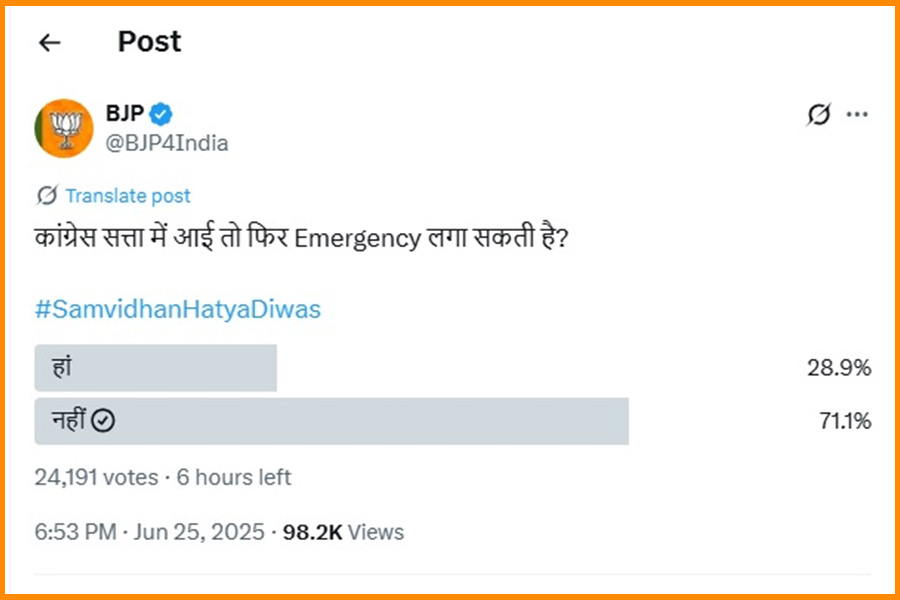|
|
The birth of young groups experimenting with stagecraft makes one optimistic about the next generation of Calcutta’s theatre fraternity, though the acid test will be how many of their personnel continue in this field, say, five years later. Tin Can is now two productions old, after a stunning beginning with Intro in 2006. This time, it invested in a big-budget, spectacular production titled Video (picture); always a fraught decision because it carries the risk of the technical overpowering the human elements. My critical antennae immediately turn hypersensitive in such cases.
One thing Video accomplished was the expression of youthful angst and anger at the world confronting them, particularly the frustrations of the less privileged, through the wasted lives of a migrant on the lam in Mumbai and that of a slum boy embroiled in political warfare in Calcutta. Another achievement was, in the root sense of the title, “to see”, the strikingly visual impact at all times, jointly designed by Soumyak Kanti De Biswas and Tanaji Dasgupta, something that many an established group could learn from. The third positive was the high-voltage energy level of the cast.
But raw emotions and a sophisticated eye do not guarantee great art. The mind must invent creatively, and the ear is just as important in theatre. Over half of De Biswas’s text was derivative — from Shakespeare’s Macbeth and Hamlet, Beckett’s Waiting for Godot, Stoppard’s Rosencrantz and Guildenstern Are Dead — betraying a limited Eng-lit education. The remainder of the script was plain weak: an unbelievable police encounter summed it up, in which the Mumbai guy, surrounded by three cops, blasts each one in turn (while the others twiddle their thumbs). Try that on policemen in real life and see where it gets you.
As director, De Biswas operated technology for its own sake, as in ‘Have gadget, will use’. One can defend the smoke machines for realistically giving spectators an overdose of urban pollution, as something acrid in them made us cough our lungs out. Ultraviolet-lit dances, strobe-lit fights, torchlights crisscrossing in the dark, inessential footage and projections — all these are theatrical clichés. None of them were deployed here innovatively. Borrowed promiscuously, virtually all the images in Video I have seen elsewhere. A common justification for this bricolage style is postmodernism, which, in inexpert hands, only means lack of originality.
A few sustained performances stood out: of Sumeet Thakur in hectoring film-hero mode and Anubrata Basu as the Calcutta boy. Anjum Katyal’s otherwise powerful “Future Song” seemed ideologically out of place, not fully thought-through: since everyone else was young, why couldn’t one of them sing about their future? Surely Generation Next has undiscovered singers worth hearing?
The importance of well-crafted dialogue came across by contrast in the unadvertised Sthalantar, the eponymously-titled debut by Souptic Chakraborty. Written during a National School of Drama workshop under Mahesh Elkunchwar, it depicted communication breakdown within a marriage, the same sequences played out in different sets on video like a multi-episode TV serial, to show their repetition in other couples' lives and in fictional reel life too. This was video directed with a purpose, not just for effect. Chakraborty also has a wry sense of humour — in the play, the husband had forgotten the names of his wife and serving boy, nonchalantly addressing them by random new names every time he talked to them. Supriya Shukla, Bhupendra Hazarika and Sajal Mondal acted quite maturely, given that it was their first effort together.
Rabindra Bharati University’s drama department received welcome training in the avant-garde from Steve Clorfeine in Jhunki, staged open-air at the Tagores’ historic courtyard in Jorasanko. Supported by the American Center, Clorfeine brought to the students his improvisatory experience under such famed American directors of performance art as Meredith Monk and Ping Chong. Jhunki presented impressionistic shards of interlaced movements and memories, including spoken parts developed by the twenty-odd performers in Bengali. It opened evocatively, with Calcutta waking up to the cries of street hawkers, drawing our attention to the precisely rehearsed and even sung nature of these “found sounds”. The site-specificity diminished afterwards, but other scenes that lingered were the synchronization of circus clowns and intercut solo storytelling. Best of all, Clorfeine’s residency exposed the future of Bengali theatre to fresh theatrical methods.











